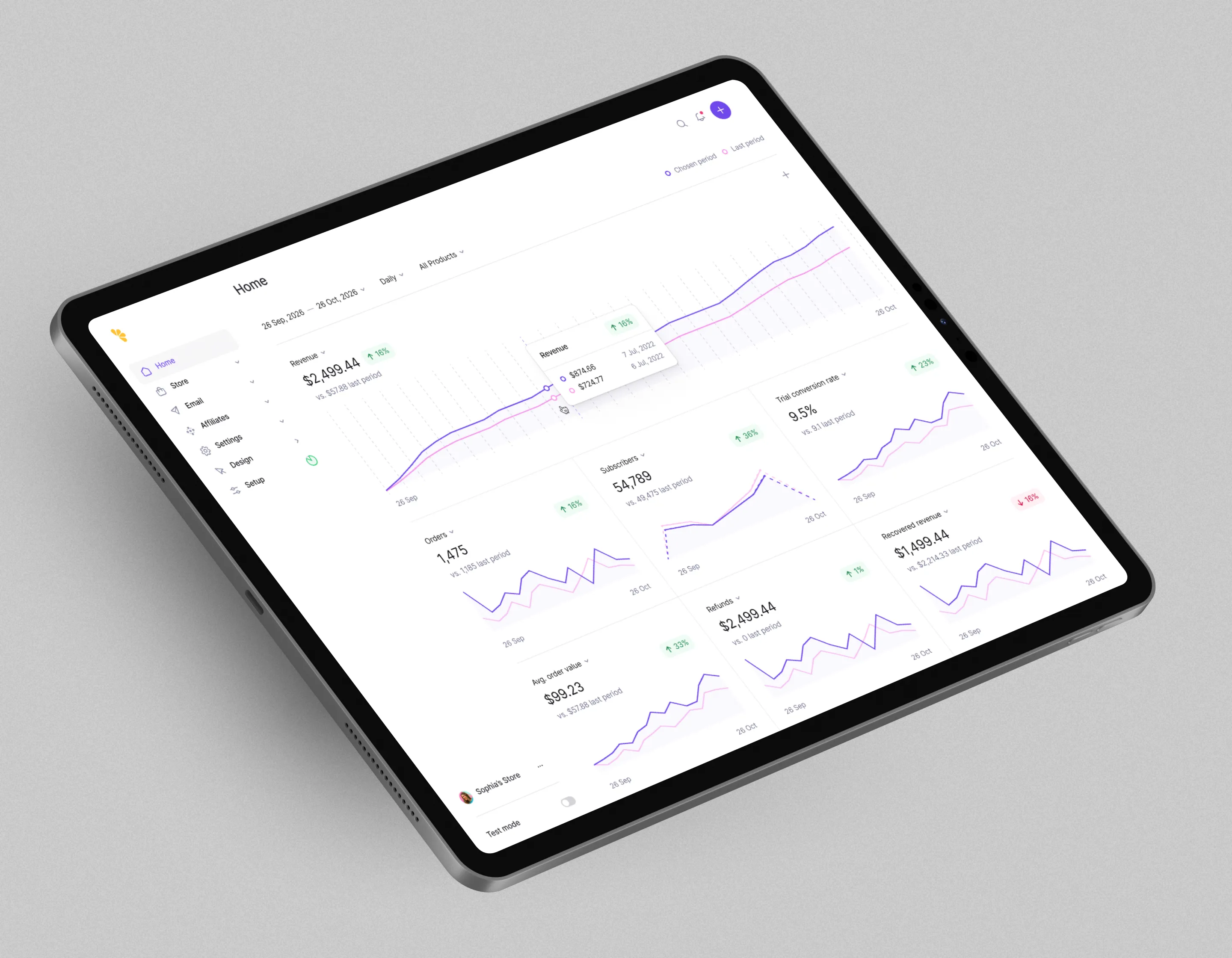
3 most important metrics when running a SaaS business
Author
Date
Category
There are exactly three things that can destroy your business – a bad product, big expenses, and unhappy customers. And not in that right order.
When you do business, you notice that these three factors are even more connected than any of us think. But even though expenses mean your money is leaking out of your company, and a bad product means that it doesn’t have a high market value, it’s the unhappy customers that can make or break a business.
Your business revolves around your customers. That’s why I tend to obsess over customer retention as each customer leaving means less revenue, and more money spent on research, retargeting, and other steps.
So if you want to run a successful company, it’s time to get acquainted with the three most important metrics.
- LTV – Customer Lifetime Value
- CAC – Customer Acquisition Cost
- CRR – Customer Retention Rate
Forget about usage or market share. These are the factors that will define your success.
1. Customer Life-Time Value (LTV)
LTV is best defined as the total revenue contribution from a customer over a certain period of time.
Why does LTV matter for your business?
- It shows the financial stability of your company
- It helps you understand the value of your CAC
- It determines the payback period (the time it takes for your customer to “pay off” their acquisition cost)
Let’s say that the monthly subscription in your company is $20. The higher the number of customers who renew their subscriptions, the higher will your revenue be.
In 2016, the LTV benchmark was $125,000 (when studied companies’ results were sliced by bookings) based on 48 months of customers lifetime. On average, the companies with that LTV had $445,000 monthly recurring revenue, and their revenue churn was below the annual average of 5% – 3.1%.
However, it takes time (usually a few years) to be able to measure your LTV correctly. This means you need a steady base of users, and your product shouldn’t be changing much. In the early stage of starting a company, you won’t find the traditional way of measuring LTV useful.
On the other hand, you need to understand what moves LTV.
The CEO of Infer, Vik Singh, uses the current period to determine LTV. That is, he doesn’t determine LTV – he predicts it and compares actual actions to his previous forecasts.
Singh’s formula for predicting LTV is:
Expected LTV = ( $30K (average ACV) + $30K (average ACV) * 1.15 (renewal increase) * (1.15 (renewal increase) ^ (3-year lifetime – 1) – 1) / (1.15 (renewal increase) – 1) = $104,175
He uses data on his competitors and the average figures (e.g. figures for Annual Contract Value) in the industry to predict his SaaS LTV.
Using this formula, you can observe what happens when you change the figures, so you’re proactively forecasting the success of your company through LTV.
You don’t have to wait for years to get accurate data; you can continuously predict and adapt as necessary.
The reason why Customer Life-Time Value is such an important metric for companies is that it shows the health of your business model, and helps you make smarter decisions.
Understanding this metric is key to proactively creating even more value, retaining customers, and surviving out in the open (market).
2. The influence of customer acquisition cost (CAC) on your business
In short, CAC is defined as the resources your company has to allocate to acquire a new customer.
Usually, when we talk about CAC we talk about marketing and sales resources. However, CAC also includes human resources (salaries, employee benefits, etc.) and technical resources.
Each expense you have is in direct correlation to your CAC and plays a significant role in the health of your business model.
CAC matters for your business because:
- Like LTV, it shows you if you need to invest more into your product, or pause and regroup
- It shows your marketing ROI and the effectiveness of different strategies and channels
- It can help you improve your product
- It can help you manage your revenue and expenses more efficiently
CAC is highly subjective, so there’s no such thing as a high or low cost of acquisition that can be applied to every company.
Let’s say your product has a subscription of $20/month. If your CAC is $15, that can be too high. However, if your monthly subscription is $250, then $15 isn’t that much.
In order to be able to assess if our CAC is worth the price we pay, we take a look at the LTV to CAC ratio. The ideal LTV-CAC ratio is 3:1.
This means that if the average customer is bringing in $1,500 over a set period of time, you should be spending around $350 to acquire them.
The farther away you get from 1:1, the better will your CAC be. And if a customer is bringing in 3 times as much as you’re spending on them, that shows that you’ve got a sustainable business.
CAC is usually calculated by diving the total spend by the number of customers acquired.
Calculating CAC per channel
Depending on which means of acquiring customers you use, you can also use CAC to calculate their usefulness. This is where CAC really helps you improve your ROI on separate channels, and calculate the value of customers acquired through different ones.
Let’s say you’re running three separate campaigns; one is local (billboards), the second is social media (Facebook), and the third is direct (cold calls).
You can calculate your overall CAC, and then divide it by channels to assess the rate of success.
If you’re not satisfied with your CAC, you can reduce it by:
Testing your product, subscription model and pricing
If the customers take too long to be acquired, it’s worth looking into whether your subscription model and pricing fit them. If you’ve used the freemium model, you could try free trial or vice versa.
You can also modify your offering to improve your CAC and LTV. Sometimes products can be too confusing for the end-users, and high CAC comes out of needing multiple steps in the sales funnel.
Does your team have to get involved to close the deal? If so, that increases your CAC, and you may want to consider changing it.
Optimizing your conversion rate
Sometimes all it takes to reduce your CAC is optimizing your conversion rate. Depending on the channel and the audience segments you’re targeting, you can adjust the funnel.
Use free or low-cost options
If you want to reduce your CAC, look into other ways of acquiring customers that don’t require you to increase your spending. Focus on inbound methods as opposed to outbound, which require you to constantly invest.
For example, referrals and word-of-mouth marketing generate 70% more customers than other means. If you’ve got a base of loyal customers, leverage them to acquire new ones.
Additionally, you can also try marketing through social media groups (as opposed to advertising), and SEO for improving organic traffic (as opposed to very expensive PPC campaigns).
This also helps you test different channels, and you may even find that some audience segments respond better to low-cost ways of acquiring them.
3. Customer retention rate (CRR)
Now that we understand the importance of CAC and LTV for your company’s success, it’s time to see how to retain customers.
By retaining customers, you’re increasing your LTV, and this can reflect on your CAC, as well.
To focus on improving your customer retention, you have to calculate it first. All you need are three variables:
- Number of customers at the end of a time period (E)
- Number of new customers acquired during that period (N)
- Number of customers at the start of that period (S)
The formula for calculating customer retention rate is:
Customer Retention Rate = ((E-N)/S)*100
It’s almost impossible for your CRR to be 100%, but aiming for 85-90% is pretty reasonable.
Since the real reasoning behind calculating CRR is ensuring a steady revenue, you can also calculate DRR (Dollar Retention Rate).
Dollar Retention Rate shows you the percentage of actual revenue you retain. DRR doesn’t look at actual customers you retain, just the loss from a gap in the number of customers, or success if you constantly get new revenue.
However, keep in mind that if you’re not actually retaining customers, you’re risking running out of revenue. Even if your DRR is good, your CRR shouldn’t be far behind for your company to grow sustainably.
For the clearest results, DRR should be calculated on a cohort basis, with each time period presenting a new customer cohort.
Calculating DRR is also useful for tracking whether your customers downgraded. If you’ve retained them, you won’t see a shift in your CRR, but your DRR will show you if they’re making you money.
With DRR, you can go above 100%, and that’s exactly what you should be going for.
Keep in mind that increasing your DRR is not the ultimate churn solution. It is on paper and as far as graphs are concerned, but when it comes to growing your company, the key is in retaining the actual customers.
That’s why it’s important to invest in product optimization and customer service.
At the end of the day, it’s the people who are paying you month after month that will help your business grow. That’s where your focus should be.
Whatever stage of your journey, we’re here to help
No matter the stage of your company, we stand behind our promise to provide exceptional customer support, from initial setups to massive migrations and everything in between.
Invest in your business with peace of mind that we're here for you whether you need technical help or business advice.

Creator Guide
Looking for some advice on how to sell and market your digital products? Download the creator’s guide to dive deep into getting your idea off the ground.

Merchant of Record Guide
Free guide for all entrepreneurs and organizations explaining why partnering with a Merchant of Record is more important than you might realize.

Want merch?
Want some fresh Lemon Squeezy swag with all the lemon puns you could ever imagine? The wait is almost over as we’re gearing up for a limited-time merch drop.

Book a demo today and get your own personal guided tour of Lemon Squeezy
Still have questions about Lemon Squeezy? Book a call with our sales team today and we’ll show exactly how we can revolutionize the way your business handles global payments and sales tax forever.

Need help?
If you’re looking to get in touch with support, talk to the founders, or just say hello, we’re all ears.









